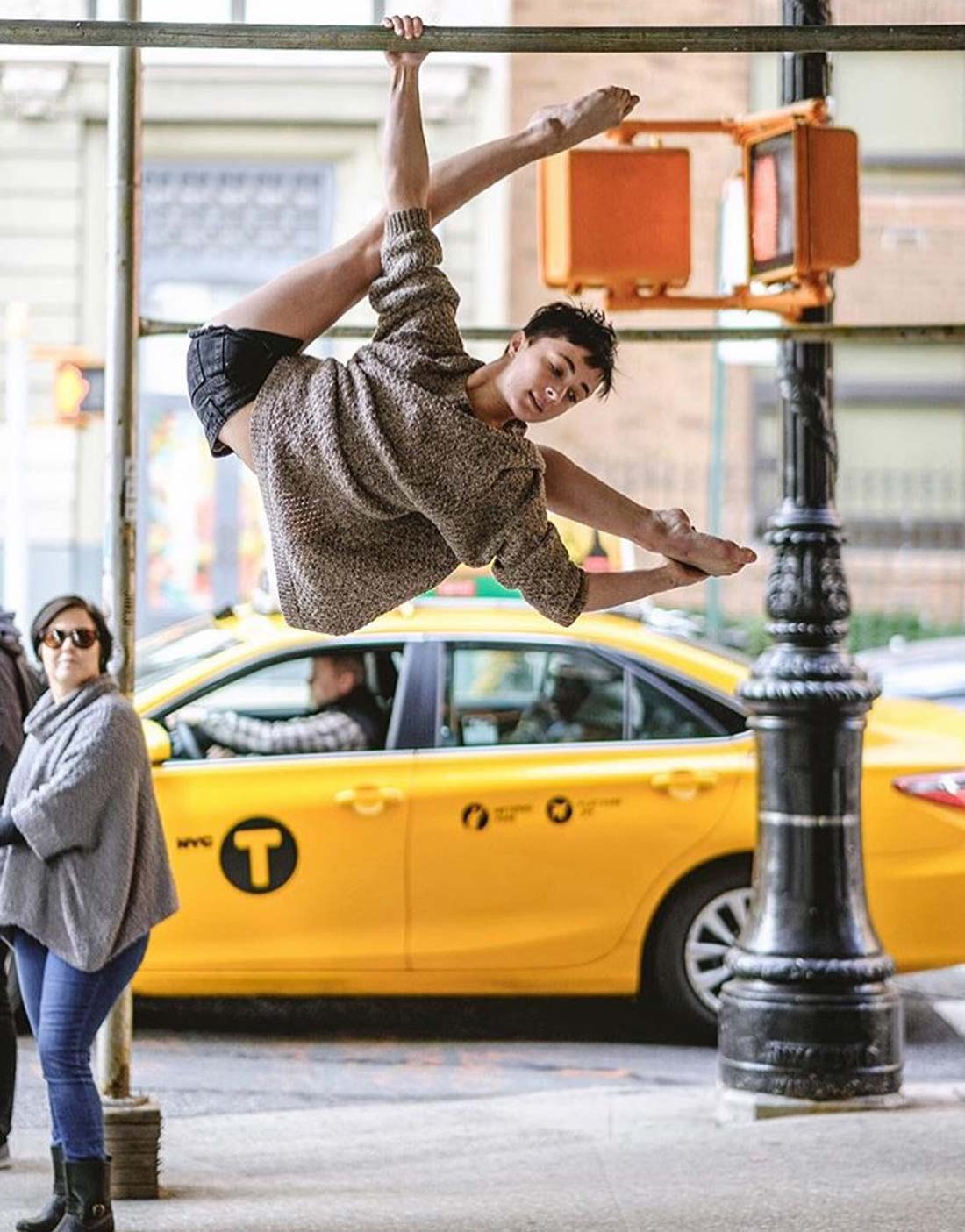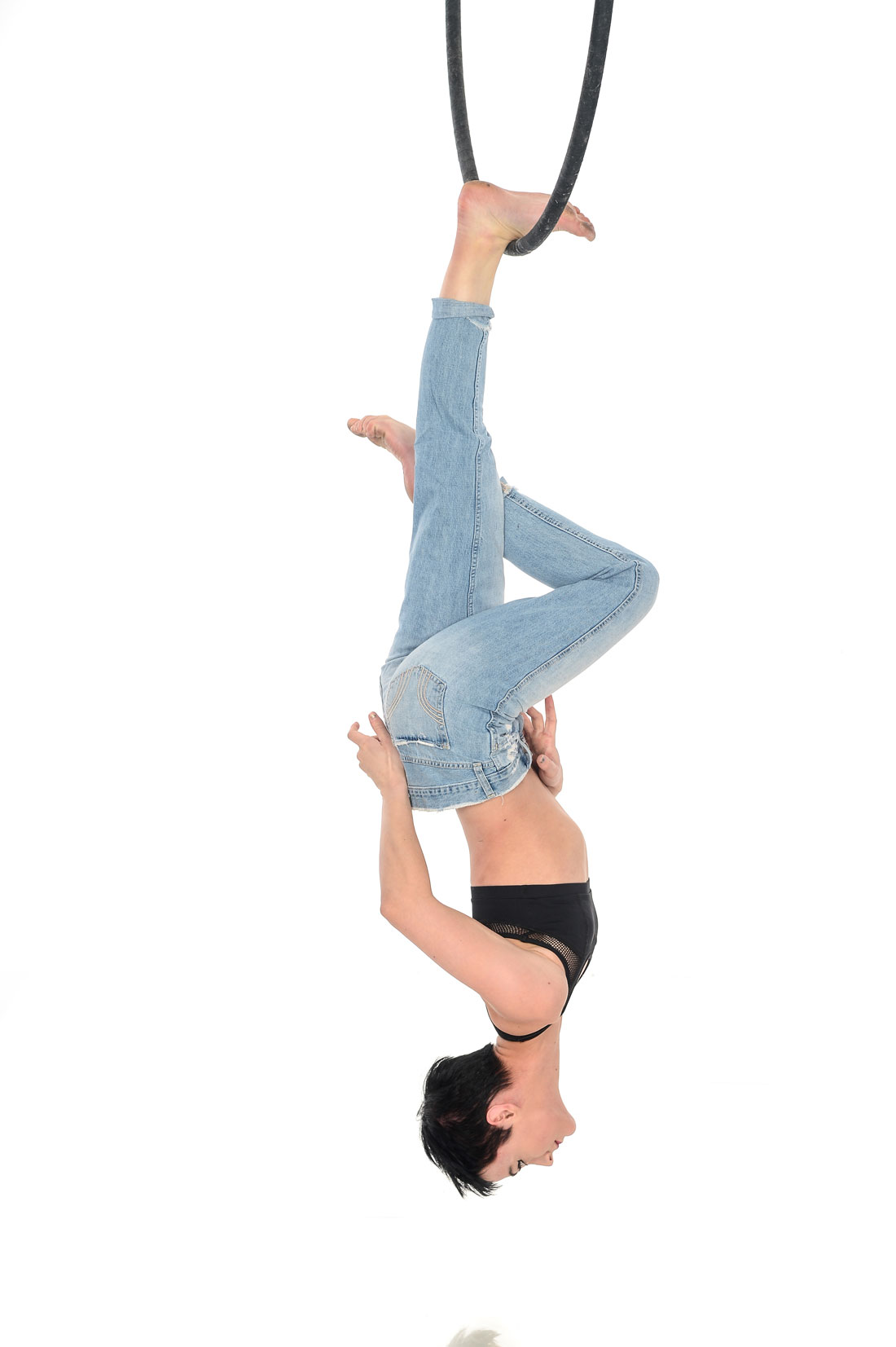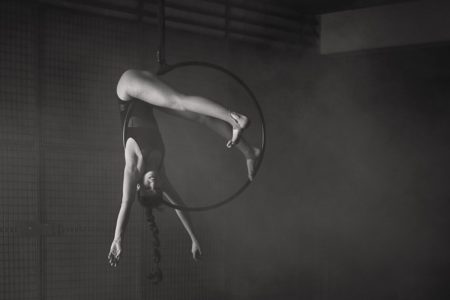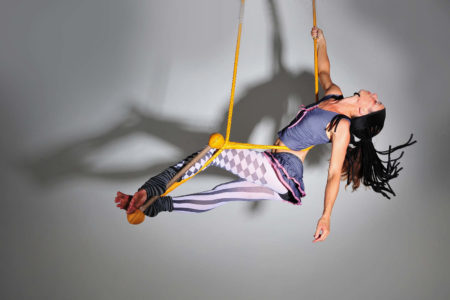Rebekah Burke studied ballet and contemporary dance at the North Carolina School of the Arts with Ethan Stiefel, Ellison Ballet in New York City, the Gelsey Kirkland Academy of Classical Ballet, and at American Ballet Theatre’s summer intensive in New York City. Rebekah studied Cerceau/Aerial Hoop with Jan Manke in NYC, at Le Studio in LA and on her own in Fredericksburg, VA. She has performed on a freelance basis in NYC and LA and was most recently a member of the cast of Queen of the Night in NYC.
1. Rebekah, could you please tell me about yourself?
How was your story of becoming an aerialist? What was your biggest challenge and how you overcame it?
I began as ballet dancer training at the University of North Carolina School of the Arts until I was about 16.
That’s when I moved to NYC for ballet school. About two years later I decided I wanted to quit ballet. At the same time I found a gig working as a dancer with an aerialist; and when I saw the aerialist perform I thought it looked like a lot more fun! I trained under her for a few months and then on my own a bit in NYC and privately with Jan Manke at Circus Warehouse. When I was 19, I moved to LA and trained at Le Studio for a year. I then moved to Virginia (where my hometown is) and trained on my own for a bit before moving back to NYC and joining the cast of Queen of the Night.
A big challenge for me has been that, from the beginning, I wanted to break the rules and do my own thing as an aerialist. I had to learn that I first needed to get strong and learn the rules — and then break them. That was definitely a practice in patience for me and taking that step back was well worth it. It was a lesson learned, and I think it’s a lesson that will continue to be learned throughout my journey as an aerialist and performer.
 Photo: Omar Robles
Photo: Omar Robles
2. How has your background in ballet and contemporary dance influenced your style in aerial arts?
What inspired you when creating your own style? What does color, for example, changing your hair color, mean for you as an artist?
Ballet and dance training influenced my style in a more subconscious way, than in a conscious way. My body always loved spinning so when I’m on the hoop I think it naturally begins to make shapes that it would when turning in ballet. A big part of ballet is that you’re constantly projecting energy through space and there’s awareness in every inch of your body. And a big part of my work is that there is awareness and purpose in every movement that my feet and legs make, which differs from what another aerialist, without the intense training in ballet that I had, may look like in the air.
When creating my own style my extracurricular interests really inspired me — such as Warhol era art, artists and punk music. And more importantly the fact that I always want to do what people tell me not to do. When a teacher told me to grow my hair out, I went and shaved off half of it. Haha! That was like a gateway drug and ripping off the bandaid to being my own person. The crazy colors soon followed. But I realized that what makes you different is actually what makes people want to see you perform, you just have to be crazy and brave enough to go for it.
3. Do you also train with some other aerial apparatus? Why have you chosen aerial hoop?
I don’t train on many other apparatuses, but when I do it has to spin! That’s why I chose hoop, because of my love of spinning 🙂 I’ve dabbled in chains and a little straps, but I think I’d really like to get into dance trapeze next.
4. How does your usual day look like? How long and how often do you train and stretch?
How does your stretching and warming up routine before the performance differ from you one before the training?
It really depends on if I’m in a show or not. Usually when I’m not in a show or on a break from a show, I’ll train on a hoop for about two hours, in a gym for about one hour, and then work on my act development (character work, story boarding etc) for about another two hours. And I’ll do this about six days a week. When I’m in a show I’ll warm up for about an hour beforehand, I’ll try to fit in around an hour of training time on my hoop and then a lot of my training comes from the work I do in the show.
Warming up and stretching before a show will usually focus on cardio and getting my heart rate up quickly so I can get ready for my act. Stretching will focus on my body parts that will be used the most during the show and the tricks that I’m performing. When I’m training I like to cover everything and really focus on warming up from core outwards.
5. Do you travel a lot performing? Could you please share some funny or, maybe, unexpected episode during your performances?
I actually have yet to perform that much while traveling, but I can say that when I do travel, my hoop and luggage don’t usually arrive at my destination with me — they usually show up a couple of days later! I have the worst luck traveling with checked luggage…no matter the weather.
 Photo: Ray Tamarra
Photo: Ray Tamarra
6. How do you create your aerial hoop transitions? Could you give some tips for interesting transitions in the aerial hoop flow?
How is your creative process when preparing choreography? How do you choose your music for your performances?
The best way I’ve found to find transitions is to think of a sequence that I’ve been wanting to try, get on my hoop while it’s static, try the sequence, clean it up to my liking, and then try it with a spin. As soon as I see how the hoop works with the movement and where it wants to go during the spin I can see possibilities for, “Oh! My leg can go here, my arm can go through here, and the spin of the hoop will pull me back over to here.”
Finding and choosing music is still a nemesis of mine. I either can’t find anything or I like everything and can’t decide what song to use. In fact, if any one has any tips for this please let me know!
7. What is the most important in a performance from your point of view?
Telling a story. If you have a literal story that you’re telling it will add a purpose to your movement that the audience will feel. They might not get the exact story that you’re telling, but they will find their own.
8. What precaution tips can you give for aerial hoop lovers?
Did you ever have injury and how have you cured it?
Don’t try anything that you’re not strong enough to do, and don’t let peers or competition pressure you. I fractured my shoulder a few years ago trying a dislocate move that I absolutely wasn’t strong enough to do — because I didn’t know better.
9. What tips or exercise can you give to master a neck hang on the aerial hoop?
Skin. Gather up all that neck skin and practice squeezing your shoulders to your ears. Eventually, when you’re able to let go, you can practice that feeling of keeping your shoulders squeezing, but releasing your arms downwards.
10. What exercises would you recommend to our readers for one hand hangs and one hand hang with a split?
Everyday when you train, practice just hanging for as long as you can, even when you think you can’t hold on anymore keep hanging. Do those with both hands and with one hand on each side. Also, practicing meathooks through straddle and alternating back and forth.
11. You were distinguished as Women’s Lyra Champion in the 2015 U.S. Aerial Championships in New York City in February 2015.
How was that experience?
The U.S. Aerial Championships was a great experience and I feel it came at exactly the right time in my life and career. I had been training my act in Virginia and needed to perform it; but I was nervous that I wouldn’t be able to find the right atmosphere for it because I felt I was doing something a little different. Winning and getting the acknowledgment from the competition really helped my confidence to go out and start performing my own act and with my own artistic vision.
12. Many artists also like to model, what inspires you when modeling?
What message do you want to transmit through your photos?
The modeling that I do is usually an artistic collaboration, and I tend to work with photographers who are friends so it has more of a feel of playing around and creating. Sometimes there will be a message that I’m trying to convey, or a feeling, but a lot of time I just want to make something pretty. I am a huge fan right now of creepy poses and poses that are simple with something intricate, such as fingers woven together and positioned a certain way.
13. Where one can book you for a show? Do you also give classes?
You can find my contact information on my website or through my Facebook Page.
I teach private lessons to intermediate and advanced students. You can contact me directly for information on location and rates.
Featured Photo: Ryan C Jones
 Talk with aerial and equestrian circus artist
Talk with aerial and equestrian circus artist Talk About Aerial Training With Aurélie Bernard
Talk About Aerial Training With Aurélie Bernard Interview with Amy Hastie
Interview with Amy Hastie